It Started With Cugnot's Fardier
To begin talking about our forefathers
search for a mode of transport to replace the horse
would necessitate traveling back in time over 300 years.
Inventions (or what perhaps could be better described
as contraptions) utilizing wind power and even elaborate
clockwork gearing were all tried, up to the advent of
steam power.
The oldest surviving self-propelled vehicle,
Cugnot's 1770 “Fardier” owes its preservation
to the fact that on its trial runs it ran amok and knocked
down a wall! Put into store, it survived the French
Revolution, was acquired by the Conservatoire des Arts
et Métiers in Paris in 1799, and has been a major
exhibit there ever since.
It was followed by a number of even less practical
designs from optimistic French, English and American
engineers, and it was not until 1801 that the first
successful road carriage appeared. The brainchild of
Cornish mining engineer Richard Trevithick, the road
carriage would in-turn lead to the development of his
London Carriage of 1803, which made a number of successful
runs before being dismantled to power a hoop rolling
mill.
Trevithick lost faith in the practicability of
his own inventions, and although they came very close
none were perfected. Other inventors of the day could
see his vision, and so began developing a range of supposed
“vehicles”, although they were all ill-founded
and better suited to science fiction.
The ideas ranged from machines driven by articulated
legs, tiny railway engines running inside a drum like
squirrels, the use of compressed air and, alarmingly,
gunpowder!
The Advent Of The Steam Engine
Then, between 1820 and 1840, came a golden
age of steam, with skilled engineers devising and operating
steam carriages of advanced and ingenious design; men
like Gurney, Hancock and Macerone all produced designs
which were practicable, capable of achieving quite lengthy
journeys and operating with a relatively high degree
of reliability.
Walter Hancock, a better mechanic than businessman,
operated his steam coaches on regular scheduled services
in London in the 1830s, but his finances were quickly
depleted by unscrupulous associates. Hancock eventually
called it a day after 12 years of experimentation had
brought him little more than unpaid debts with the associated
hostility of his creditors.
And as you would expect, the politicians of the day
displayed a total lack of vision. Many were convinced
that the “Steam Carriage” would prove a
threat to the thousands whose livelihood depended on
the horse, and so they implemented tolls on the turnpike
roads.
An 1831 Parliamentary Commission, though largely
favorable to the steam carriage, failed to prevent the
introduction of the road tolls – thus delivering
a near fatal blow to the builders of steam carriages.
It would be a few years later, with the advent of the
railway age, that would finally put to rest the “Steam
Carriage” industry.
Railway engines had the advantage of running on smooth,
level rails, while the Steam Carriages were forced to
use uneven, badly maintained roads. The Railway was
big business, providing huge profits and returns for
the railway owners. As you can imagine, big business
had the ear of the local politicians of the day.
They
were quick to point out that the Railways major competitor,
the Steam Carriage, could be considered unsafe given
they were using “public” roads filled with
half-witted pedestrians, and so in 1863 legislation
was passed requiring every Steam Carriage to have a
man with a red flag must walk ahead. It was only the
development of the bicycle in the 1860s which would
allow the hapless public to again tour by road.
The Internal Combustion Engine
While the
internal combustion engine appeared early
on in the history of the motor vehicle, it would take
over three-quarters of a century for it to be perfected
to the level where it could be used in a vehicle capable
of running on the roads. The 1805 powered cart of the
Swiss Isaac de Rivaz was little more than an elaborate
toy, capable of crawling from one side of a room to
another, while the 1863 car built in Paris by JJ. Etienne
Lenoir took three hours to cover six miles. It was not
until the mid-1880s that the first successful petrol
cars appeared, developed independently by two German
engineers, Gottlieb Daimler and Karl Benz.
It was Karl Benz’s vehicle that was incontestably
superior. While Daimler had “adapted” a
horse drawn vehicle, Benz had designed a vehicle from
the ground up, utilizing new technologies from the cycle
industry for his inspiration. The three-wheeled vehicle
that Benz developed would go into limited production
– it being described in his catalogue as “an
agreeable vehicle, as well as a mountain-climbing apparatus”.
By 1888 Daimler had decided to concentrate on selling
his engines as a universal power source, but interestingly
neither would find immediate success.
The Steam Engine's Last Gasp
Instead the Steam Carriage made a final comeback, particularly
with some of the advanced designs of the Boll family
of Le Mans. These carriages, built between 1873 and
the mid-1880’s, were to pioneer such advancements
as independent front suspension. Meanwhile one Léon
Serpollet , a blacksmith's son, conceived a 'flash boiler'
capable of the instantaneous generation of steam.
Serpollet
would soon be the proud bearer of the very first driving
licence to be issued in Paris. And while the Comte De
Dion and his engineers Bouton and Trépardoux
built some excellent steam vehicles during the 1880’s
and early 1890’s, they were to achieve their greatest
fame as manufacturers of light petrol vehicles, from
1895 onward.
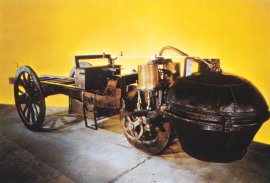
Cugnot's 1770 “Fardier”
survives to this day because it crashed on its
trial run...
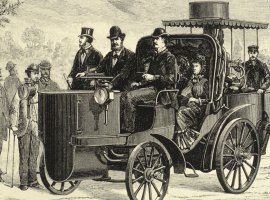
The Bollée Mancelle Steam
Carriage of 1873 would require a man to lead
it waving a red flag should it contemplate using
London roads...
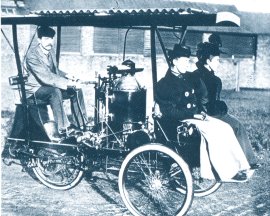
This 1895 Tri-Car used a Leyland
steam lawnmower engine, and its mid-mounted
location had absolutely nothing to do with improving
handling...
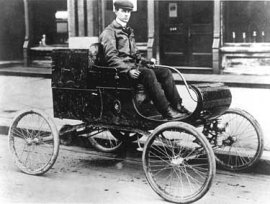
In the early 1900's the most
famous of the "Gas Buggies” was the
Curved-Dash Oldsmobile...
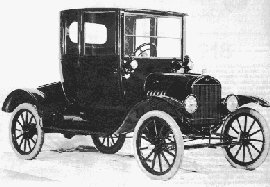 Arguably Ford's greatest achievement
was to introduce the 1908 Model T, a car that
would became so popular that he was forced to
introduce the car industry's first moving production
line... Arguably Ford's greatest achievement
was to introduce the 1908 Model T, a car that
would became so popular that he was forced to
introduce the car industry's first moving production
line...
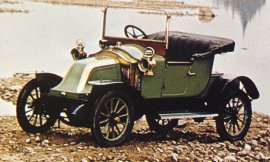
The Twin Cylinder Renault AX
helped ferry troops to the battle of Marne and
save Paris in 1914 at the hight of World War
1...
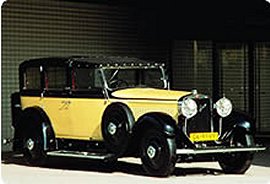
Hispano-Suiza put their aero
engine expertise to full account in the 1919
32CV of 6.6 litres, a splendid automobile featuring
servo-assisted four-wheel brakes and delightful handling characteristics...
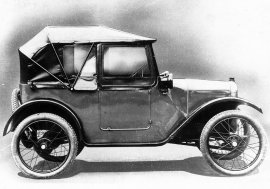 After the war it would take until
1922 for the motor industry to get back on course
with a second generation of post-war popular
cars - most notable was the Austin Seven... After the war it would take until
1922 for the motor industry to get back on course
with a second generation of post-war popular
cars - most notable was the Austin Seven...
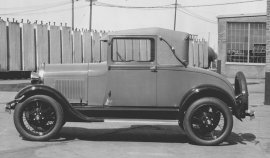 During the 1920's features were
introduced to make motoring more comfortable
and safer. Windscreen wipers, electric starters,
low-pressure tyres and, first standardized on
the 1928 Model A Ford, safety glass... During the 1920's features were
introduced to make motoring more comfortable
and safer. Windscreen wipers, electric starters,
low-pressure tyres and, first standardized on
the 1928 Model A Ford, safety glass...
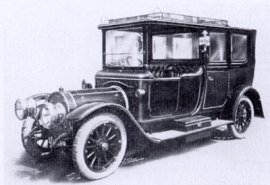 The Delaunay-Belleville may have
been the very best of French cars and and favourite
marque of the Tsar of Russia, but that wasn't
enough to save it during the 1920's... The Delaunay-Belleville may have
been the very best of French cars and and favourite
marque of the Tsar of Russia, but that wasn't
enough to save it during the 1920's...
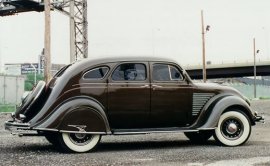
During the 1930-35 period streamlining
became the vogue, as evidenced in such classics
as the Chrysler Airflow...
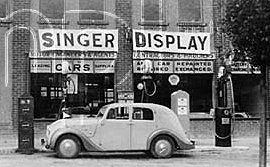
Though most cars still retained
running boards, lower door edges gave a lower,
more bulbous look, accentuated by the adoption
of wings with side panels, often blended into
the radiator and bonnet, as seen here on with
the Singer Airstream...
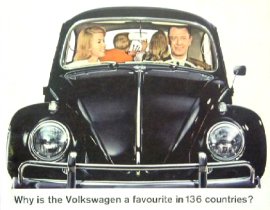 Volkswagen went from strength
to strength after WWII, despite opinions from
British experts - and from Henry Ford II - that
the VW was too noisy and uncomfortable to be
competitive... Volkswagen went from strength
to strength after WWII, despite opinions from
British experts - and from Henry Ford II - that
the VW was too noisy and uncomfortable to be
competitive...
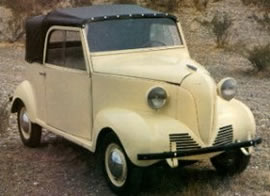
Companies like Crosley stood
little chance against the "Big Three"
during the 1950's... |
The 1889 Paris World Exhibition
The biggest turning point for the automobile, and the
internal combustion engine, was arguably the 1889 Paris
World Exhibition. It was at this exhibition that French
engineers Panhard and Levassor saw the Daimler 'Steelwheeler'
car powered by the Daimler vee-twin engine. Levassor's
lady friend, an astute widow named Louise Sarazin, held
the French rights to the Daimler engine in succession
to her late husband, and Panhard and Levassor began
manufacturing these power units in 1890.
They could,
however, see no future for the motor car, and so granted
the right to use Daimler engines in self-propelled vehicles
to Peugeot (then an ironmongery and cycle firm) who,
as luck would have it, had just made the decision not
to proceed with the production of the “Serpollet
Steamers”.
Around the same time, and also in France, Emile Roger
managed to sell a handful of Benz cars. Ironically Roger
would garage his first Benz in Panhard and Levassor's
workshop. But things were about to change, particularly
with Benz’s first four-wheeler, the 1893 Viktoria.
Peugeot were already established as motor manufacturers
by that date, for in 1891 they had actually sold 5 cars,
boosting production to a dizzy 29 the following year.
The success of the Peugeot cars forced Panhard and Levassor
to reconsider their early opinion of the horseless carriage,
and, after building a couple of crude dogcarts with
the engine at the rear, Levassor devised the famous
Systéme Panhard, with the engine at the front
driving the rear wheels via a sliding pinion gearbox
inspired by the mechanism of a lathe, a layout which
endures on to this day.
Development in America
In America, the motor car was evolving quite independently
of the goings on in Europe. During the first part of
1891 a petrol powered friction-driven three-wheeler
built by John W. Lambert of Ohio City made its first
tentative runs. In 1895, America's first motor manufacturing
company was founded by the Duryea brothers, Charles
and Frank (whose
prototype dated from 1893); the following
year they exported a couple of vehicles to Britain.
Perhaps the railroads of the day considered the emerging
automobile technologies as impinging upon their turf,
or a general population lacking in vision, for whatever
the reason there was little interest in the new motor
vehicles (be they home-grown or imported), although
the so-called “father of the British motor industry”,
H. J. Lawson, succeeded in parting a good many credulous
investors from large sums of money.
Lawson knew that, for the automobile to become successful,
the ridiculous legislation requiring a red flag waver
to walk in front of any vehicle would have to be repealed.
Fortunately for Lawson he had friends in high places,
and on November 14 1896 he organized a commemorative
run to Brighton to celebrate the raising of the speed
limit to 12 mph.
Ironically many of the participating
automobiles would travel much of the distance by train,
while the first car home, a Duryea, was not one of the
marques under Lawson's control, he having purchased
at great expense most of the motor car patents in an
ill-founded attempt to monopolize the British car industry.
Demand for motor cars continue to grow steadily during
the latter part of the 1890s, and by now the Benz had
become the world's most popular car, with the 2000th
production vehicle being delivered in 1899. Motoring
was still the sport of a few rich eccentrics, however,
and many people, particularly those in country areas,
were yet to even see a car!
The 1000 Miles Trial
In an effort to “showcase” the new technology
to the masses, the Automobile Club of Great Britain
and Ireland held its famous 1000 Miles Trial, taking
in most of the major cities of England and Scotland.
A total of 65 cars, many English Daimler and MMC models
built by Lawson's empire, set out from Hyde Park Corner,
London, in April; the majority finishing the run without
major mishap, proving that the car had at last become
a reliable mode of transportation and offered a clear
alternative to horse and buggy.
The Turn of the Century was ushered in by 'the car
of the day after tomorrow', the Mercedes, designed by
Daimler's engineer, Wilhelm Maybach. The contract to
produce the first batch of 30 cars had been signed within
a month of Gottlieb Daimler's death in March 1900.
They
had been ordered by the wealthy Austro-Hungarian Consul
at Nice, Emil Jellinek, who insisted that they be christened
after his daughter Mercedes, a name which found such
favour with the wealthy car-buying public that all German
Daimler cars were soon known by that name.
The advanced design of the Mercedes, which combined
in one harmonious whole elements such as the honeycomb
radiator, pressed steel chassis and gear-lever moving
in a gate rather than a quadrant, 'set the fashion to
the world' and soon many high-priced cars were copying
its layout; even comparatively small cars like the Peugeot
were built on Mercedes lines.
These cars did not, however, represent the popular
motoring of the early 1900s; this was the province of
single-cylinder runabouts like the De Dion and the Renault.
In the US the designers favoured the light, but considerably
more temperamental, steam cars such as the Locomobile;
these were soon followed by “Gas Buggies”,
of which the most famous was the Curved-Dash Oldsmobile.
Ford vs The Association of Licenced Automobile Manufacturers
That the US automobile industry was taking some time
to advance can be found in the monopolistic attitude
of the time. A patent lawyer named George Baldwin Selden
had drawn up a 'master patent' for the motor vehicle
in 1879, published it in 1895 and claimed that all gasoline-driven
vehicles were infringements of that patent. His claims
were eventually given commercial teeth by the Association
of Licenced Automobile Manufacturers, established to
administer the Selden Patent in 1902, to which most
major American car firms were persuaded to belong.
It was Henry Ford, who had founded his Ford Motor Company
in June 1903, that decided to take the fight up to Selden
and the ALAM. Proceedings were initiated in 1904 and,
after lengthy litigation, the ALAM built a car to Selden's
1879 design while Ford built a car with an engine based
on that of the 1863 Lenoir. Ford won the day in 1911
- not long before the Selden Patent would have expired
anyway - but the victory established him as a folk hero.
The Model T
Ford's great achievement, after five years' work, was
to introduce in October 1908 the immortal Model T, which
became so popular that he was forced to introduce the
car industry's first moving production line in order
to build enough cars to satisfy demand. His 'Universal
Car' changed the face of. motoring; over 16.5 million
were built before production ended in 1927, truly 'putting
the world on wheels.
Though the Edwardian era saw motoring become more popular,
on the other hand it also saw the finest and most elegant
cars of all time, built to a standard of craftsmanship
which could never be repeated. After World War One,
many of the great marques faded away in a genteel decline:
Delaunay-Belleville, 'the Car Magnificent', the favourite
marque of the Tsar of Russia and one of the very best
of the French cars of the pre-1914 era, became just
a petit bourgeois in the 1920s.
Napier, the British company which popularized the six-cylinder
engine, enjoyed perhaps even greater acclaim than its
rival, Rolls-Royce, while its sales were controlled
by the overly pompous Selwyn Francis Edge; when Napier
gave him a £160,000 “Golden Handshake”
after a dispute over policy in 1912, however, the company's
fortunes seemed to leave with him. Edge, having agreed
to leave the motor industry for seven years, became
a successful Sussex pig farmer; Napier built very few
cars after the war, concentrating instead on its aero
engines.
The Growth In Popularity Of The Cycle Car
The European car industry was under considerable economic
pressure from that in the US. The latter was manufacturing
automobiles using predominantly unskilled labour on
their new production lines, while the former relied
heavily on a pool of highly skilled, lowly paid craftsmen,
all of whom were expected to take pride in their work
and consider the automobile a piece of craftsmanship
rather than an object of mass production.
Inevitably
it was the big luxury cars that stood little chance
– for they represented only a tiny fraction of
the potential market for the motor vehicle and, even
if their production had not been decimated by the drying
up of the car market as a result of the war, they would
inevitably have died out as a result of the social changes
in the post-war world.
Europe, indeed, experienced an outburst popular motoring
in the 1910-14 period which owed nothing to American
concepts of mass production; instead, it grew out of
the motorcycle industry, whose engines, single-cylinder
or Vee-Twin, offered lightness and power
Optimistic
enthusiasts installed these engines in chassis of often
suicidal crudeness, with cart-type centre-pivot
steering in many cases, as well as other un-mechanical devices
such as wire cables coiled round the
steering column
instead of a conventional
steering box and drag link,
belt and pulley transmission and tandem-seat layouts
with the driver in the second row.
These crude devices,
known as cycle-cars, flourished predominantly in England
and France; attempts to mimic their success in America
failed because they were simply unsuited to the very
different motoring environment.
While the cycle-cars were short-lived, it was during
this period that the future direction of the automobile
industry could be seen, in new “light” cars
such as the Morris Oxford, the Standard and the Hillman.
These cars were all built on the one principle, to afford
large vehicle characteristics on a smaller scale, using
cheap, economical and easy to manufacture engines with
capacities around the 1000cc mark. These admirable machines
were to be the pattern for the popular family cars of
the 1920s.
The Combustion Engine's Role In World War 1
During the first war it was the
internal combustion
engine that afforded new mobility to the infantry who,
before hostilities in Europe came to a standstill in
the trenches, could be rushed to reinforce weak points
in the front line - most notably when the French General
Gallieni sent 6000 reinforcements to repel Von Kluck's
attack on Paris in 1914.
Motorcycles were used to issue
military dispatches, while armoured cars and tanks would
become an increasingly familiar sight on the front lines.
But perhaps the biggest advance of the
internal combustion
engine was in the air, aerial combat adding a new and
deadly dimension to modern day warfare.
Post War Boom, and Bust
In the post war period there was an automotive boom
time, especially in Britain and France. The established
manufacturers had little hope of meeting the new demand,
and so a new cottage industry of companies manufacturing
light cars and cycle-cars from proprietary components
soon developed. Most however were to only find commercial
failure.
If the European car industry had any chance against
the US giants, the notion of mass-production needed
to be embraced. André Citroén, a former
gear manufacturer, decided to bring Ford-style mass-production
to France. We would enjoy an immediate success with
his 10bhp launched in 1919. However, the rise of Citroén
spelt doom for the dozens of hand-assemblers who clustered
most thickly in the north-western suburbs of Paris.
The boom collapsed in 1920-21, speeded on its way by
strikes, hold-ups, shortages, loss of stock market confidence
in the car industry, restrictions on hire-purchase sales,
costlier raw materials, and the introduction of a “horsepower”
tax in Britain. Only the fittest survived: Ford, whose example was
followed by a number of American and European makers,
cut prices in order to boost falling sales.
In Ford’s
case, he was able to compensate for the loss on the
cars by compelling every dealer to take $40 worth of
spare parts per car – the spare parts affording
no price reduction. Even the mighty Ford was, however,
forced to close down for some months to clear unsold
stocks. It was not until 1922 that the motor industry
was back on course and a second generation of post-war
popular cars began to emerge, most notably the Austin
Seven.
Many of the cars of the 1920’s profited from
the technology of the aero engines developed during
the war, cars such as the overhead camshaft Hispano-Suiza
V8. Wolseley built this engine under licence and used
an overhead camshaft on their post-war cars, but it
was not until after the 1927 takeover by Morris that
this Wolseley design realized its full potential, especially
in MG sports cars.
The Automobile Matures
Hispano-Suiza put their aero engine expertise to full
account in the 1919 32CV of 6.6 litres, a splendid automobile
featuring servo-assisted four-wheel
brakes and delightful
handling characteristics, whose overall conception was
several years ahead of any of its rivals. Meanwhile
Bentley, who had built rotary aero engines during the
war, brought out an in-line four with an overhead camshaft
in 1919 (though it was not put into production until
1921); this 3-litre was to form the basis of one of
the worlds most immortal sporting cars.
Many leading manufacturers adopted the overhead camshaft
layout during this period, but Rolls-Royce, whose aero
engines had used this layout, stuck resolutely to side
valves on their cars until the advent of the 20 in 1922;
this had a pushrod OHV configuration, although the Silver
Ghost would retain side
valves till the end.
Oddly enough, apart from honourable exceptions like
the Hispano, it was the cheaper cars which pioneered
the use of
brakes on all four wheels, one of the most
positive advances in car equipment in the early 1920s.
Possibly it was felt that luxury cars would be handled
by professional drivers, who would be less likely to
indulge in the kind of reckless driving that would require
powerful brakes! Moreover, some American popular car
makers, appalled at the cost of retooling their cars
to accept
brakes on the front wheels, actually campaigned
against their introduction on the grounds that they
were dangerous. Ralph Nader would have had a field day!
As the decade wore on, more features designed to make
motoring more comfortable and safer became commonplace-windscreen
wipers, electric starters, safety glass (first standardized
on the 1928 Model A Ford), all-steel coachwork, saloon
bodies, low-pressure tyres, cellulose paint and chromium
plating all became available on popular cars. Styling
and the annual model changes became an accepted part
of the selling of motor cars, bringing with them huge
tooling costs which could only be borne by the biggest
companies. Many old-established firms were simply unable
to keep up, being swept away by the onslaught of the
depression in 1929.
The Depression
Was it the depression that made people less inclined
to enjoy the concept of open-air motoring, or was it
the practicalities of fending off the elements. Whatever
the case, the switch from open-tourer to saloon bodies
was well under-way by 1931; by this time some 90% of
all cars being “Tin Tops”, a complete reversal
on the number produced only 2 years earlier.
In a concession to the difficult economic times, manufacturers
were also forced to develop smaller engines, and in
turn lighter car bodies and lower ratio gear boxes.
As a result, the cars of the day were required to rev
hard to afford any pretence of performance, and naturally
their bores wore alarmingly. The days when durability
was a feature taken for granted on all but the shoddiest
of cars seemed long past.
The design of cars now began to change radically as
well. The demand for more capacious
bodywork on small
chassis led to the engine being pushed forward over
the front axle. The
radiator became a functional unit
concealed behind a decorative grille which became more
elaborate and exaggerated as the decade wore on.
During the 1930-35 period
streamlining became the vogue,
as evidenced in such classics as the Chrysler Airflow,
the Singer Airstream and the Fitzmaurice-bodied Ford
V8. Even on more staid cars, the angularity of line
that had characterized the models of the late 1920s
gave way to more flowing contours. Though most cars
still retained running boards, the separate side valances
were eliminated by bringing the lower door edges down
to give a lower, more bulbous look, accentuated by the
adoption of wings with side panels, often blended into
the
radiator and bonnet.
The swept tails of the new-style coachwork now concealed
a usually well laid out luggage compartment, a feature
sadly lacking on most 1920s models, which usually boasted
a luggage grid and nothing more. By contrast with the
cars of the 1920’s, those of the 1930’s
offered considerably greater comfort and convenience.
One problem, however, was that the stylist had taken
over from the engineer and designer; thus little thought
was given to their
aerodynamics or road holding ability.
While there was no going back to the old-fashioned designs,
many wished they could!
New suspension systems, especially independent front
springing, also brought their own
handling problems.
In fact, some cars had to be fitted with bumpers incorporating
a harmonic damping device to prevent them from simply
shimmying right off the road on their super-soft springing.
But it wasn’t all doom and gloom, with some manufacturers
producing some excellent cars. Morris and Austin would
continue to build soundly engineered small cars (though
Herbert Austin was distinctly upset when his designers
insisted on moving the
radiator behind a dummy grille.
Henry Ford was personally involved in the development
of two new models, the 8hp Model 19Y and the V. Both
cars were released in 1932, and were instantly and deservedly
successful.
In France the famous
front wheel drive Citroén
would make its debut in 1934. Unfortunately the development
costs had all but bankrupted André Citroén,
and he was forced to sell out to Michelin. Of the cars
with more sporting pretentions, the SS marque were producing
beautiful looking, beautiful
handling and beautifully
built cars, and for a very reasonable price.
The same year that the SS Jaguar was launched (1936)
Dr Ferdinand Porsche built the
prototype Volkswagens,
the 'Strength through Joy' cars sponsored by the Nazi
Party and intended to be sold to the German public.
Was the argument to bring cars to the German masses,
or was it to prevent them purchasing foreign manufactured
cars? Whatever the reason, this most popular of designs
would go on to sell over 20 million and establish itself
as the most popular car of all time (and we will not
be drawn into comparisons with the Toyota Corolla).
Few Volkswagens, however, were built before the war
(though the design was readily adapted for military
purposes).
In many ways the 1930s were a watershed - they saw
the last of the big luxury cars from makers such as
Hispano-Suiza, Duesenberg and Minerva, as well as the
end of many small, independent manufacturers and coachbuilders
(victims of the swing to mass-produced cars with pressed-steel
bodies). The motor industry had reached the point where
it had become vital to the economic well-being of the
major industrialized countries. Now it was to prove
just as vital in providing weapons of war.
Europe Braces For War...Again
In Britain, five of the largest motor manufacturers
set up “shadow factories” in the late 1930s
- used in the production of aero-engine and parts in
the event of war. This foresight would see them manufacturing
many thousands of aero engines and complete aircraft
during the hostilities. Ford joined the fold soon after
the outbreak of war, building Rolls-Royce Merlin engines
on a moving production line in Manchester, while in
the USA Ford mass production expertise was given its
greatest test in manufacturing Liberator bombers on
a gigantic production line at Willow Run, Michigan.
From the ubiquitous Jeep, through staff cars, trucks,
tanks and powerboats to the biggest bomber aircraft,
the motor industry played a crucial role in World War
Two. Re-adapting to peacetime production was, however
' to prove almost as big a test of the industry's abilities.
After the war there was a huge materials shortage –
but despite significant government interference most
car manufacturers were soon to return to production.
The first examples to roll off the production lines
were inevitably only slightly modernized pre-war models,
although some manufacturers such as Armstrong-Siddeley
were able to immediately manufacture all-new models.
Despite shortages of fuel and tyres, there was a vast
demand in Europe for cars. Despite a huge shortage in
Britain, the government mandated that manufacturers
export half their output – you could be forgiven
for thinking the best way to win a war is to loose it
first, Speculators (scalpers) soon entered the fray,
buying new cars and selling them at an inflated profit
– soon purchasers were forced to sign a 'covenant'
guaranteeing that they would not resell for initially
one year, this later being extended to two years.
There was much talk of technical developments arising
from wartime projects, but devices such as automatic
transmission were only generally adopted in America,
and reports that hydraulic suspension, or springing
by rubber or torsion bars, were about to be adopted
on British cars proved to be more than a little premature.
Indeed, some makers seemed unready to come to terms
with the future, as one report noted: 'Since wind resistance
is an important factor in brake performance,
streamlining may lead to braking difficulties, as was shown in experiments
carried out in France'.
European manufacturers faced the daunting task of having
to rebuilding their often totally destroyed manufacturing
plants. The French automotive industry had sustained
the biggest loss of machine tools and equipment, most
being shipped to Germany under the occupation. The German
industries had sustained considerable bomb damage, and
having the country divided into two entities posed even
bigger problems.
The Reichsmark was replaced by the Deutschmark, creating
an effective devaluation of around 100%. Nevertheless,
the country's most prolific manufacturer, Volkswagen,
continued to make progress despite opinions from British
experts - and from Henry Ford II - that the VW was too
noisy and uncomfortable to be competitive. And though
the BMW factory had ended up in the Russian Zone, the
first-and only- 'War Reparation' design to come out
of Germany became the BMW-based Bristol 400.
A shortage of sheet steel and
tyres also helped to
keep production to about a sixth of the 1938 level in
1946-48, though some recovery was apparent by 1949 when
the first post-war car show was held in Paris –
by this time production had risen to about four times
the 1938 monthly level.
The 1950's, A Period Of Turmoil
By the time of the 1950’s the motor industry
was entering a period of traumatic change. Those brave
attempts by independent companies like Kaiser and Crosley
to carve a foothold in the American market against the
corporate giants of the Big Three (Ford, GM and Chrysler)
were to quickly amount to nothing. Old and well established
independents like Packard, Nash and Studebaker were
in decline and would soon vanish, either by attrition
or by merger. The American car industry had become stereotyped,
offering up to the public a diet of overly large, poor
road holding behemoths being driven by large 6 cylinder
or even larger V8 engines.
The 50’s ushered in the era of the exaggerated
tailfin and the grinning chrome grille, and the 'performance
car' capable of superlative top speeds, but being unsafe
around any corner. Small “compact” cars
were developed in 1959, of particular importance to
Australians was the Ford Falcon and Chrysler Valiant
– both becoming a staple of the Australian family
alongside the GM Holden. Then there was the unorthodox
rear-engined Chevrolet Corvair, bringing Ralph Nader
notoriety with his best selling book “Unsafe at
any Speed”.
Mergers and amalgamations were not only confined to
the US. In Britain, Austin and Morris would join, but
this was never a happy association. Commentators predicted
a decline in the British automotive industry –
and they were uncharacteristically correct. BMC (British
Motor Corporation), British Leyland and others, all
producing small family cars, were unable to crystal
ball their own demise at the hands of union trouble
and the emergence of the Japanese as an automotive power
house.
The Importance Of Fuel Efficient Cars
Fuel economy became even more significant after the
1956 Suez War, when petrol was rationed in many countries,
and the event created a new breed of cycle-cars, which
today we refer to as “Bubble Cars”, such
as the Heinkel, Messerschmitt and Goggomobil. The “Bubble Cars” may have been “cute”,
but they were primitive devices and not well liked at
the time.
Their saving grace was their fuel economy
– should someone design a comfortable AND economical
car they would be doomed. That person was Alec Issigonis
– and his design - the 1959 Mini Minor. Now “Cheap
and Cheerful” could also mean decent engineering,
comfort and handling. The Mini’s layout of front-wheel
drive and transverse engine was to set the pattern for
the coming 20 years and more.
But the 1950s had their glamour cars, too: Britain
produced the big Healeys, the Triumph TRs and the first
MG to abandon the per perpendicular lines of the 1930s,
the slippery profiled MGA, even available with a temperamental
twin-cam engine; Italy built big, powerful sports cars
like the Ferrari America and Super America; France,
which had taxed the Grand' Routiers like Delahaye out
of existence, introduced the avant-garde Citroen DS;
and Germany, free of any war repatriation responsibility,
were to release the distinctive
Mercedes 300SL Coupe – one of the most highly sought after sports cars
to this day.
Also see:
The History of Australian Motoring - Looking Back On Forty Years of Motoring by W. H. Lober
The Sports Car
Great British Pre-War Sports Car
Founding Fathers Of The Automotive Industry
The Automotive Industry, Pre World War 1
The Automotive Industry, Between The Wars
The Automotive Industry,
Post War
The Weird And Wonderful Car Inventions 


